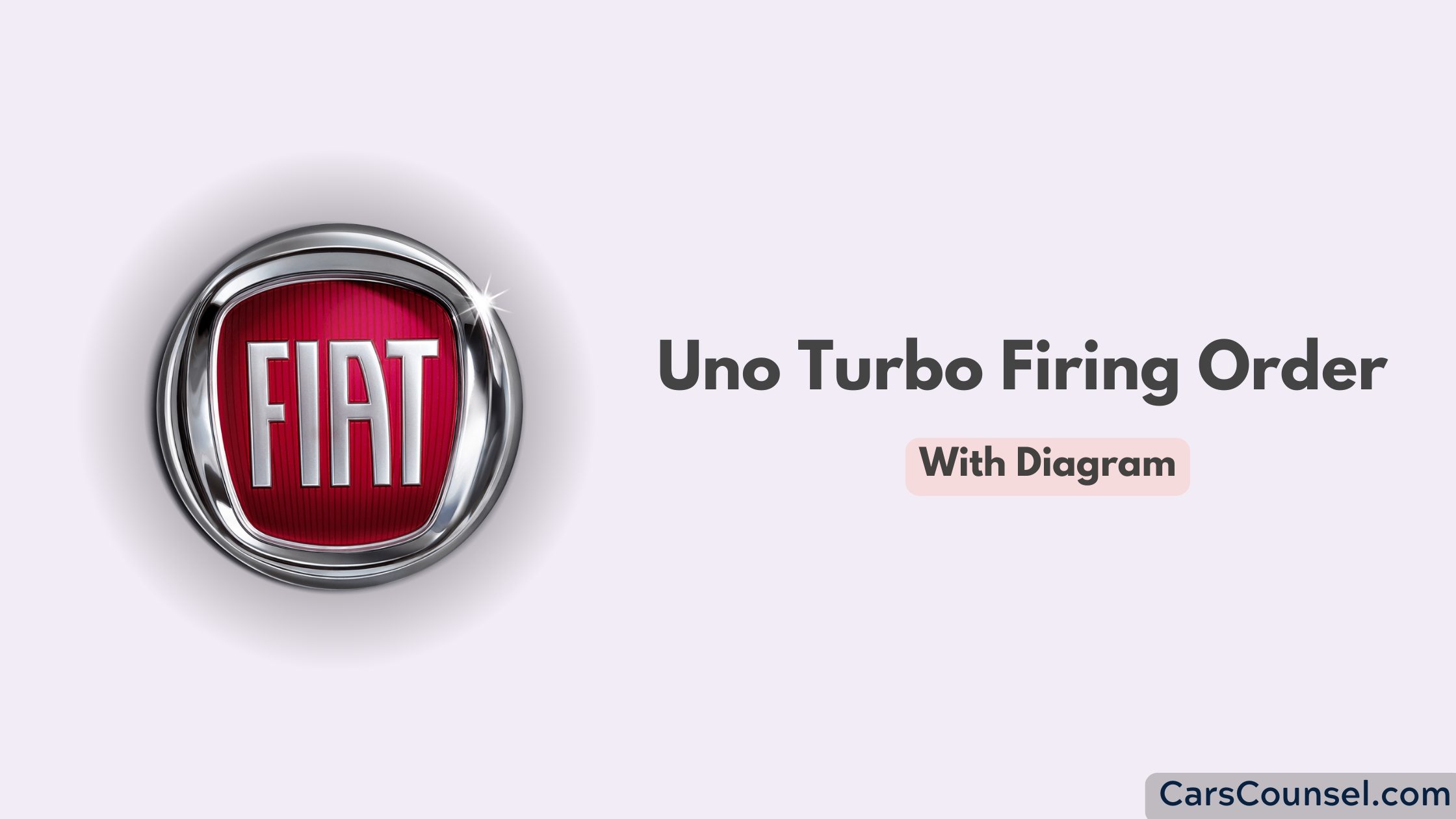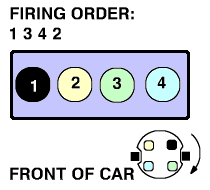When it comes to the Fiat Uno Turbo, understanding its engine’s firing order is crucial for optimal performance, proper maintenance, and effective troubleshooting.
The firing order governs how the engine’s cylinders ignite their air-fuel mixture, ensuring smooth operation, balanced power delivery, and efficient combustion. In this article, we’ll explore everything you need to know about the Uno Turbo’s firing order, its significance, and how to maintain or troubleshoot it effectively.

Quick Navigation
What is the Firing Order?
The firing order is the sequence in which an engine’s cylinders fire, igniting the air-fuel mixture to generate power. Each cylinder fires at a precise moment, synchronized with the engine’s rotation and the opening and closing of its valves.
For the Uno Turbo, the firing order is 1-3-4-2, a standard pattern for most inline-four engines. Each number corresponds to a specific cylinder, and the sequence repeats in continuous cycles as the engine runs.

This sequence ensures:
- Smooth engine performance by balancing power strokes.
- Minimized vibrations for a quieter operation.
- Maximized efficiency by optimizing the combustion process.
How the Uno Turbo Firing Order Works
Breakdown of the Sequence:
- Cylinder 1 Fires First: The ignition process starts here, producing the first power stroke.
- Cylinder 3 Fires Next: The next spark plug ignites cylinder 3, continuing the power delivery.
- Cylinder 4 Fires Third: Cylinder 4 fires, maintaining the engine’s balanced operation.
- Cylinder 2 Fires Last: Finally, cylinder 2 ignites, completing the sequence before the cycle repeats.
This sequence ensures that the engine produces consistent power while preventing imbalances that could strain components or cause excessive vibrations.
The Importance of the 1-3-4-2 Pattern
The 1-3-4-2 firing order is engineered for efficiency, balance, and durability. Here’s why it matters for the Uno Turbo:
Balanced Engine Operation
The firing order spreads the power strokes evenly across the crankshaft’s rotation, preventing uneven stress and reducing vibrations.
This balance is especially important for a turbocharged engine like the Uno Turbo, where precise operation is critical.
Efficient Turbo Performance
In turbocharged engines, the firing order helps maintain a steady flow of exhaust gases to the turbocharger. This consistency ensures optimal boost pressure and prevents lag.
Durability of Engine Components
By distributing the forces evenly, the firing order minimizes wear on the crankshaft, connecting rods, and bearings, extending the engine’s lifespan.
Locating the Cylinders in the Uno Turbo
Before working with the firing order, it’s essential to understand the engine layout. The Uno Turbo features an inline-four engine, meaning the cylinders are arranged in a straight line.
Cylinder Numbering:
- Cylinder 1: Closest to the timing belt or accessory drive (front of the engine bay).
- Cylinder 4: Closest to the flywheel or gearbox (rear of the engine bay).
The numbering progresses sequentially from the timing belt end, making it easier to identify and maintain each cylinder.
Components Supporting the Firing Order
Several components work together to ensure the correct firing order in the Uno Turbo’s engine. Each plays a critical role in the ignition process:
- Crankshaft: Converts the pistons’ linear motion into rotational energy, aligning the firing order with its rotation.
- Camshaft: Controls the timing of the intake and exhaust valves, ensuring synchronization with the ignition process.
- Distributor (or ECU): Delivers electrical current to the spark plugs in the correct firing sequence.
- Spark Plugs: Ignite the air-fuel mixture in each cylinder, producing power.
- Turbocharger: Relies on the exhaust gases generated by the firing order for consistent boost performance.
Each component must function correctly for the firing order to maintain optimal engine operation.
Symptoms of Firing Order Issues
When the firing order is disrupted, the Uno Turbo’s engine will exhibit noticeable symptoms. Common problems include:
Misfires
An incorrect sequence causes one or more cylinders to misfire, disrupting the engine’s rhythm.
Rough Idling
The engine may run unevenly, vibrate excessively, or stall during idle.
Power Loss
A disrupted firing order reduces power output, leading to sluggish acceleration and poor performance.
Turbocharger Inefficiency
The inconsistent exhaust flow can cause turbo lag or prevent the turbocharger from operating efficiently.
Knocking or Backfiring
Incorrect timing may result in knocking noises or backfires due to premature combustion.
Increased Fuel Consumption
An imbalanced engine consumes more fuel as it compensates for inefficiency, leading to higher operating costs.
How to Verify and Correct the Firing Order
To maintain optimal performance, it’s essential to verify and, if necessary, correct the firing order of your Uno Turbo. Here’s a step-by-step guide:
Step 1: Inspect Spark Plug Wires
- Ensure each wire connects the distributor (or ignition coil) to the correct cylinder in the 1-3-4-2 sequence.
- Replace any damaged or corroded wires.
Step 2: Check the Distributor Cap (if applicable)
- Confirm that the cap is aligned correctly with the rotor. Misalignment can disrupt the firing sequence.
- Look for wear or cracks in the cap that could cause electrical arcing.
Step 3: Use a Timing Light
- Attach a timing light to cylinder 1 and check the timing marks on the crankshaft pulley.
- Adjust the timing as needed to align with manufacturer specifications.
Step 4: Consult the Owner’s Manual
- Refer to the manual for diagrams, wiring placements, and firing order details specific to the Uno Turbo.
Step 5: Inspect the ECU (Electronic Control Unit)
- For models with electronic ignition, use an OBD-II scanner to check for error codes that may indicate firing order issues.
Maintenance Tips for a Healthy Firing Order
Preventing firing order issues begins with regular maintenance. Follow these tips to keep your Uno Turbo running smoothly:
Replace Spark Plugs Regularly
- Worn or fouled spark plugs can disrupt the firing order. Replace them according to the manufacturer’s schedule.
Inspect Ignition Wires
- Check for cracks, corrosion, or loose connections. Replace faulty wires immediately.
Clean and Service the Distributor
- If your Uno Turbo uses a distributor, clean it periodically to prevent dirt and moisture buildup.
Monitor Engine Timing
- Regularly verify and adjust the timing to match the manufacturer’s recommendations.
Maintain the Turbocharger
- Ensure the turbocharger’s components are in good condition to complement the engine’s firing order.
Common Misconceptions About Firing Order
Misunderstanding firing order can lead to mistakes. Let’s address a few myths:
- “All Inline-Four Engines Have the Same Firing Order” While 1-3-4-2 is common, some engines may have different firing orders based on design.
- “Firing Order is Adjustable” Changing the firing order without redesigning the engine can cause severe damage.
- “Firing Order Doesn’t Affect Turbo Performance” The firing order directly impacts the exhaust flow, critical for turbocharger efficiency.
Why Firing Order Knowledge Matters
Understanding the firing order of your Uno Turbo empowers you to:
- Perform basic maintenance confidently.
- Diagnose engine problems more effectively.
- Communicate clearly with mechanics.
This knowledge not only saves time and money but also enhances your driving experience by keeping your car in peak condition.
Engines with Similar Firing Orders
- UNO 1100 Firing Order
- UNO 1400 Firing Order
- 2009 Mini Cooper Firing Order
- 2011 Mini Cooper Firing Order
Conclusion
The firing order of the Uno Turbo, 1-3-4-2, is a cornerstone of its engine’s performance and efficiency. By maintaining the correct sequence and ensuring all related components are in good condition, you’ll enjoy smooth power delivery, optimal turbo performance, and a longer-lasting engine. Regular maintenance, careful observation of symptoms, and proper diagnostic techniques are key to preserving your Uno Turbo’s reliability.
Stay proactive and informed to get the most out of your Uno Turbo, ensuring it continues to deliver the thrilling performance it’s known for.

